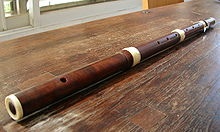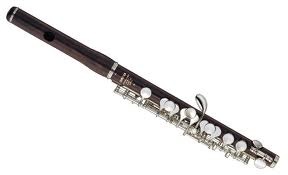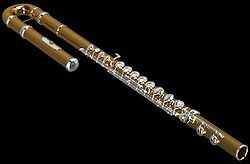Home Introduction Digital Story Audio Blog Lesson Plan Links Quiz
The
History of the Flute
The flute is one of the oldest, if not the oldest wind instrument in
history. It didn’t always look like the flute
we see today in bands, orchestras and everywhere. In fact, the
flute as we see it today is known as the “Western concert
flute” or “C flute.” Any instrument that is
long, cylindrical in shape with bored holes and a tone hole that you
blow sideways into is called a flute. Therefore, there are many,
many instruments all around the world made of different materials in
many different kinds of music that are called the “flute.” On this page you will learn a brief
history of the flute’s ancestors, the flute as we know it in the
United States and this “Western concert flute’s”
relatives.
Below are two pictures of flutes from
the first known flutes of the 11th and 12th century


Notice the picture
on the left looks like a recorder we know from general music class and
the picture on the right looks like familiar flute. In the
medieval and Renaissance times (1400-1600) these were both know
as
flutes. To delineate the difference, the flute pictured above on
the right was called a transverse flute. The word transverse
meant to blow sideways, which is exactly how one created sound on the
flute. The flutes in the picture to your above left are blown
with the mouth directly covering the tone hole. In the transverse
flute the mouth doesn’t cover the hole but rests sideways to blow
into the flute. To distinguish the two, the transverse flute was
also called the German flute. During the medieval times (1000-1400
A.D.) the flute was not a common instrument. It was only used with the
viol ( an ancestor of the violin) in music heard in the royal courts.
In the Renaissance (1400-1600 A.D.) the flute became more popular and
more widely used.
During the Baroque
era of music (1600-1760) the flute got redesigned. It was still made of
wood but now had three or four separate parts that you put together.
The head joint (the area you blow into) was redesigned into a conical
bore. An instrument with a conical bore is long and slightly
tapered (that is it gets smaller and smaller). This new shape made the
flute have a wider range of notes and made its sound more penetrating
than before. Now flutes didn’t have to be for soft, gentle music
only! Below is a picture of the baroque era flute or “trasverso
flute" as it was called then...

For the next two
hundred years great composers wrote music for the flute. Bach,
Mozart, Beethoven, Handel, Debussy, to name a few are among the very
famous composers who wrote for flute during this
time. It is estimated that there are over one million musical
works for flute! That is a lot of flute music to hear!
In 1847 the flute
as we’ve come to know it was built. Theobald Boehm patented his
invention in 1847. Still today known as the Boehm flute, its
first and most profound difference is that his flute was made of metal,
no longer wood, although, even today you can still buy a wooden
flute. The Boehm flute does not have a conical bore, instead the
tubing is completely straight (called cylindrical). The holes
that were pressed now
had pads that one pressed down in various combinations to make the
different notes. In fact, Boehm’s design for the key system
(which pad goes down when for what note) was the easiest to use
and is still ( with some minor changes) the way flutes are
made today!
The flute
has, along the way, gotten some relatives! The piccolo is the
smaller version of the flute. It is half the length of the Western
concert flute. It has the same keys but they are very
small. The piccolo is blown in the same manner as the flute but
the hole one makes with his/her mouth (embouchure) must be
made smaller to account for the smaller tone hole.

Bigger than the Western concert flute
is the Alto flute

Notice it is
longer than the Western concert flute to be able to make lower
notes. There are several bigger flutes. Each of them can play
increasingly lower and lower notes. The biggest is the double
contrabass flute.

As you can see it is quite big and
can hit notes three octaves below the concert flute. That means it can
play notes that are three TIMES lower than the lowest note on the
concert flute! But recently, the double contrabass flute is not
the biggest!!! The Hyperbass flute is even bigger and is the
biggest with its tubing being over 25 feet in length! Its lowest
note is 16Hz, not audible to the human ear! It was invented by
Italian craftsman Francesco Romei who built the Hyperbass flute only
within the last fifteen years! Here is a picture of famous Italian
flutist Roberto Fabbriciani in front of part of it!

Next move on to the Digital Story of
great flautists!








